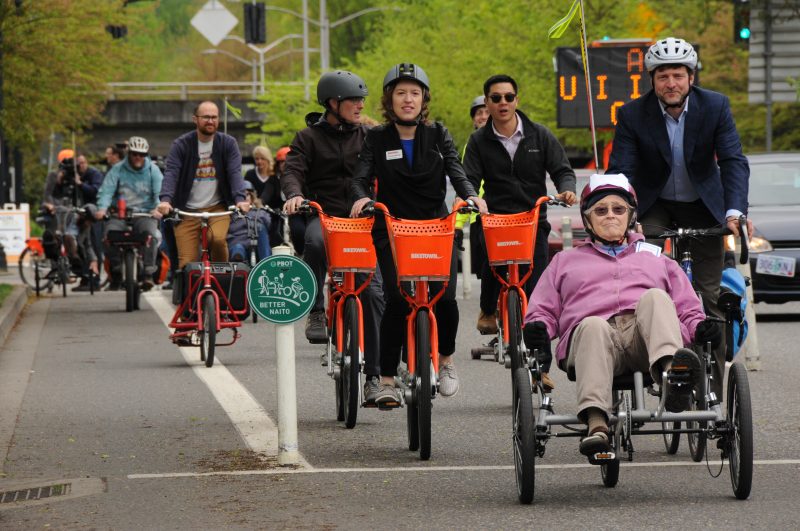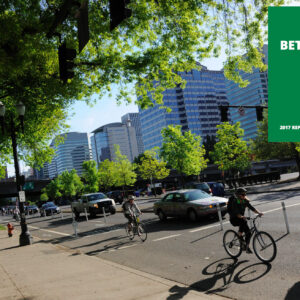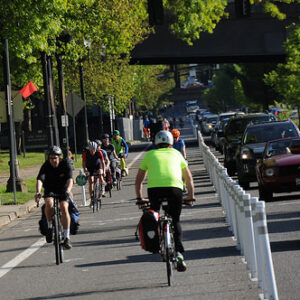
(Photos: Jonathan Maus)
“All through the long, dark winter, I eagerly await the day when bollards spring from the pavement and we know that Better Naito season is upon us again.”
With those words by Biketown General Manager Dorothy Mitchell, the City of Portland officially opened Better Naito this morning.
From now until the end of September, Naito Parkway will have more room for biking, walking and rolling between the Hawthorne and Steel Bridges. The re-allocation of road space was first made possible in 2015 by a group of volunteer activists from Better Block PDX in collaboration with planning students from Portland State University. Last year the project was taken over by the Portland Bureau of Transportation and they’ve now budgeted for a seasonal installation for the next four years.
Last year PBOT counted 500,000 trips in the Better Naito lane and it has been widely hailed as a success.
Advertisement

The seasonal approach was taken in large part to help people access the waterfront during the busy Rose Festival season. “It has truly worked,” Rose Festival CEO Jeff Curtis said at this morning’s event. “It provides an accessibility tool and it’s a smart use of space.”
PBOT Planning, Projects, and Policy Group Manager Art Pearce said that while they have four more years of funding for this seasonal installation, the City isn’t obligated to wait that long before making something more permanent. During a ceremonial parade lap of the facility, Pearce shared with me that the Central City in Motion project is where the future of Better Naito is being discussed. “We continue to work the edges to see if we can make it [a permanent version] go faster, but that’s the path forward. Better Naito is keeping the momentum going while we’re having bigger deliberations around which streets are going to change.”
With changes to Naito north of this seasonal installation made last summer and a major project on Naito to the south being constructed this summer, the pressure for “PermaNaito” is growing. “I’m relatively confident we’re going to get that,” Pearce said today.
— Jonathan Maus: (503) 706-8804, @jonathan_maus on Twitter and jonathan@bikeportland.org
Never miss a story. Sign-up for the daily BP Headlines email.
BikePortland needs your support.






Thanks for reading.
BikePortland has served this community with independent community journalism since 2005. We rely on subscriptions from readers like you to survive. Your financial support is vital in keeping this valuable resource alive and well.
Please subscribe today to strengthen and expand our work.
Hopefully one day we’ll move beyond ripping Better Naito out every autumn, and install something permanent and high quality. It’s not hard to imagine.
Here’s what Victoria Embankmet in London looked like in 2015:
https://goo.gl/maps/ndv4NMYzZjB2
Here’s what it looks like today:
https://goo.gl/maps/tzMJwRECWwx
What agency wouldn’t want a project that brings self-gratifying press and photo-op opportunities every year? A seasonal project is great source of material for conference presentations, lunch talks, and “engagement with stakeholders”. Once you make that project permanent, you have to find other examples to prove your active transportation and sustainable city credentials.
“PermaNaito” is cute, but I wish we would get past the words and go straight to where we know we’re going – a reconfigured street designed to prioritize active transportation. Oh wait – that’s wishful thinking. Can we get not just to but further than “safely accommodate active transportation”?
Or simply make all modes practical and safe, not prioritize any one based on current or projected numbers. Design a street for safety, and work from there if it needs a change.
I like “better waterfront trail.”
Naito is a nightmare again. It’s worse than The Esplanade on a sunny Sunday. The difference is being able to avoid The Esplanade. Naito is a commuters dream already. I am so sorry that you are all so afraid of traffic, but at least motorists are insured. Orange bikes ridden by people who are captivated by their device are coming at me. I can’t move to the right because of the stroller. This sucks, I have been commuting on Naito for thirteen years. A few years back Naito was for fast bikes. It was even signed that way. Pathetic approach to solving the summertime traffic problem associated with events in the park. I’ll be taking the lane.
Better Naito isn’t for you, it’s for pedestrians mainly. It also benefits slower cyclists, families, kids, etc.
Motorists are insured? Hmm. Exact quote from someone who rear-ended me a few years ago: “Insurance? Oh yeah, I don’t have that.”
Guess who doesn’t have insurance: the worst drivers, because their rates would be so high.
I couldn’t disagree more. Naito is a Darwinian place to ride a bike most of the year, while the esplanade is super slow. I abstain from riding the west side of the river until Better Naito is in tact, so that I can ride quickly to where I’m going. As with all congestion in the world, slowing happens as the grid reaches capacity, same thing goes for bikes.
Everything you just said, I literally disagree with. I avoid the waterfront path due to all the pedestrians and tourists on Biketowns. With Better Naito, I at least have a wide, safe route devoid of that madness on the waterfront path, alongside bollards that give me some semblance of safety.
Wow! Somebody woke up grumpy. While I understand the frustration of unpredictable pedestrians and bike riders, and the desire to go fast, I think Better Naito does a great job of providing a safer route for all users when taken in context of the whole transportation system in that part of downtown (waterfront MUP, Better Naito, actual Naito). Shouldn’t that be the point of a transportation system; to get the most people using the most modes to their destinations in the safest way possible? That part of downtown sees a lot of different kinds of traffic this time of year. I don’t think prioritizing commuters over all other users is the best way.
Forget better Nato and better anything else if Portland gets its new baseball stadium, which appears to be likely. Seen the latest Willamette Week?
Appears likely? The whole article is about how unlikely it currently is from both a private funding and public funding standpoint. Maybe I am optimistic, but I don’t see Portland buying into using public funds for construction of a stadium to house a sport that has declining attendance rates for the last 10 years. Say what you will if you’re a fan, but baseball dies with the boomers.
LEGGO!!!!
I rode it yesterday on an orange bike while heading to a meeting across town. I was super grateful for Naito since the waterfront park is being set up for cinco de mayo carnival now.
When is Cinco de Mayo?
who is that old bald man with the cargo bike? 🙂
Bald is beautiful! 😉
I like Better Naito. Especially southbound…I think it lowers the right hand hook risks that exist when riding the bike lane on the right, southbound side of Naito. Of course, you have vehicles coming at you separated only by plastic wands but the single traffic lane often keeps them moving slow. For those wanting to avoid the summer congestion on Better Naito…the center lane on SW 3rd is a fairly fast southbound option if you’re ok mixing with vehicle traffic.
The Central City in Motion’s budget is $8.4 million; a mile of Seattle’s new protected bike lane on Second Ave costs $12 million per mile. There are so many competing ped, bike, and transit projects in the CCIM, without any explicit commitment from PBOT, saying that Better Naito will be discussed further during CCIM, is really not meaningful at all.
Can’t help but feel like this “seasonal” approach conveniently (and maybe intentionally) provide photo-op opportunities for PBOT every year to say “hey, look at this great accomplishment”! Right now for 8-months of the year, people on bikes and foot are basically second-class citizens pushed off to the side in order to prioritize cars on Naito. A real accomplishment would be making Better Naito permanent to improve the safety and comfort of vulnerable road users everyday during the year and not just when agency leaders wants good PR.
Your first paragraph would be really depressing, but I don’t think the comparisons are quite like-for-like.
1) Under the SDC list already passed by Council there’s $20,000,000 of funding which was directed to be prioritized as part of CCIM. There are also other individual projects which are SDC eligible (i.e. NE Multnomah is eligible for $2,000,000).
2) CCIM has other opportunities to leverage funds. One huge opportunity is the reconstruction of SW 4th from Lincoln to Burnside, scheduled to happen next year.
3) A lot of of the cost of the Seattle project was in new signals. I don’t think CCIM is proposing to build completely signals. (Although there are some funded through other buckets, including in the Central Eastside).
Thanks for the additional info! I am glad there is more funding for CCIM than the budgeted $8.4 million. And I am aware the difference between the Seattle example and Naito – I think we can significantly improve safety on naito without spending $12M per mile – but my point is about intention. The response from Art Pearce doesn’t convey any intention to elevate Natito as a priority in the central city. Despite after years of experimenting with Better Naito, overwhelming public support, and data that show minimal impact on traffic, Naito still yet to get permanent improvements. It shows that the agency and the commissioner who runs it don’t feel that this is an import tang project to deliver permenantly.
Mark my words: making “Better Naito” permanent is the first step towards an outright ban on bicycles in Waterfront Park (and eventually a ban on the Esplanade south of OMSI, too).
Having to drive up and down Naito daily as part of my work commute (SE Portland to the butt end of Tigard, no good cycling or public transit options for that, sadly!), I’ve noticed that the total impact to my commute times of the southbound lane closure coupled with Better Naito is negligible. Hardly a scientific study, but I have to wonder what the impact would be of a two-lane Naito between Steel and Hawthorne, with motor vehicle access to Hawthorne and Morrison bridges (and from Morrison to Naito) closed. Closing the Morrison ramp from Naito last year was a bit of an inconvenience, but it seemed to be a boon for pedestrians and riders, particularly at the top of the ramp.